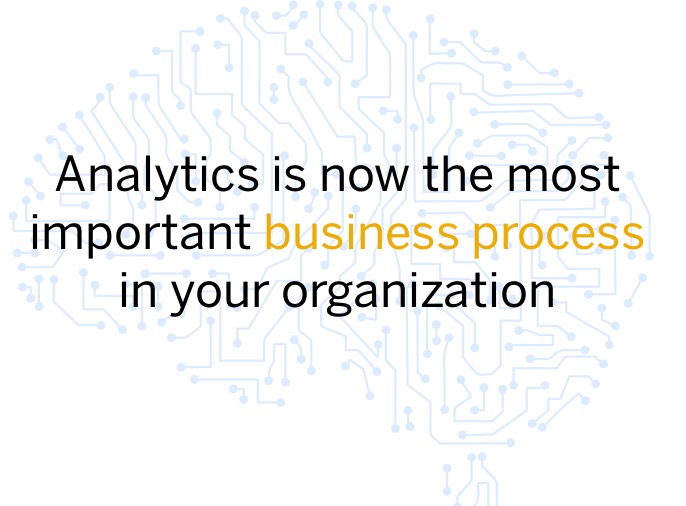It’s time to take analytics seriously!
That might sound strange – after all, analytics has been at the top of Gartner’s CIO technology priorities for decades.
 But despite that, analytics is still too often treated as an afterthought, as something used to track the effectiveness of business processes, or as a set of tools for making pretty visualizations and telling “data stories.”
But despite that, analytics is still too often treated as an afterthought, as something used to track the effectiveness of business processes, or as a set of tools for making pretty visualizations and telling “data stories.”
It’s time to change that perception. In an era of digital transformation, analytics is now the most important business process in our organizations – and it’s time for us to start treating it like one.
 According to Gartner, today’s CIOs are responsible for building the “civilization infrastructures” that are not just going to reshape business, but also the way we live.
According to Gartner, today’s CIOs are responsible for building the “civilization infrastructures” that are not just going to reshape business, but also the way we live.
There are five domains that make up these digital platforms: IT Systems, Customer Experiences, Things, Intelligence, and the Ecosystem Foundation. The domains are interconnected and independent and organizations will focus on the one or few with the most impact for them, but it’s clear that Intelligence — i.e. data and analytics — is at the heart of the organizations of the future.
For the last few decades, we’ve typically thought of business intelligence as a byproduct of our operational processes. We manufacture products, ship them around the world, and sell them to customers. Each of these processes generates a lot of data, and we use that data both to keep track of operations and to create more optimized processes in the future.
 This remains as true and important today as it’s ever been in the past. But organizations are increasingly realizing that digital transformation doesn’t just require new processes – it requires a new approach to creating and implementing business processes. They have to be more agile, more intelligent, and more responsive to change.
This remains as true and important today as it’s ever been in the past. But organizations are increasingly realizing that digital transformation doesn’t just require new processes – it requires a new approach to creating and implementing business processes. They have to be more agile, more intelligent, and more responsive to change.
 These new processes flip the traditional equation on its head. New processes are created on the fly by analytics.
These new processes flip the traditional equation on its head. New processes are created on the fly by analytics.
The typical customer journey is a great example. Think about how you purchase products today. In the old days, it was a fairly linear process that companies could characterize as a “sales funnel”. But now it’s more like a “write your own adventure” book – where there are many different possible interaction paths, and at each point in the process, you as a customer get to choose the next chapter and the next point of interaction.
 The job of modern marketers is to optimize the whole system of touch points to maximize the flow of satisfied customers. And to do that, they rely on analytics, to guide the customer at each point – “you may be interested in these other products” or “here’s a discount if you purchase now.”
The job of modern marketers is to optimize the whole system of touch points to maximize the flow of satisfied customers. And to do that, they rely on analytics, to guide the customer at each point – “you may be interested in these other products” or “here’s a discount if you purchase now.”
In the new world, it’s no longer about having a “customer process,” it’s about creating thousands or millions of personalized “processes” on the fly, based on the needs of each individual.
Because these new processes are analytics-powered, they can be much more agile and responsive to change – indeed, with new machine learning approaches, they can even update themselves, automatically adjusting to consumer behavior.
And this doesn’t just apply to marketing. We see the growth of similar on-the-fly processes in every other area of modern business, from production and logistics to finance and human resources.
Effectively creating and managing these kinds of flexible, on-the-fly processes is THE big new opportunity in digital business.
In the next post, I’ll give examples of how the latest analytics technologies are enabling more process-driven approaches to optimizing information use in modern organizations.
[Subscribe to get future posts automatically via email]
